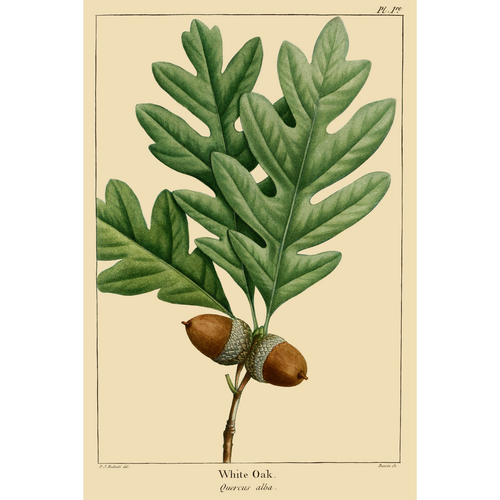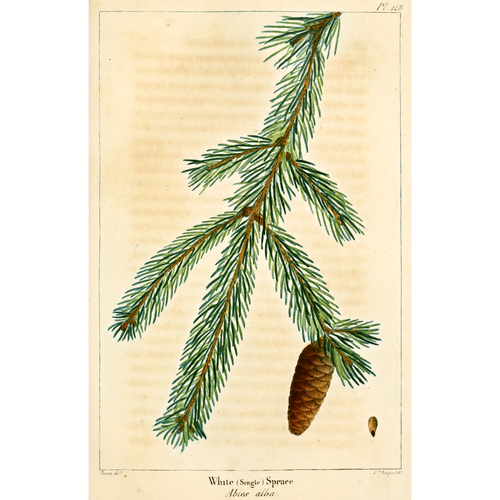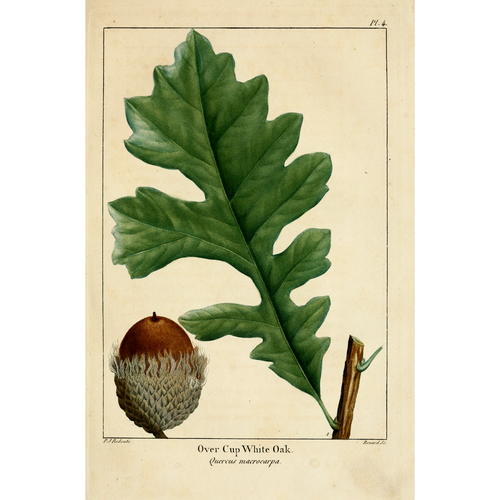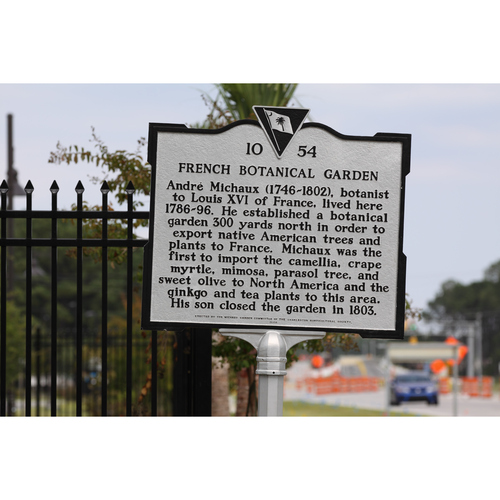MICHAUX, ANDRÉ, botanist and author; b. 8 March 1746 near Versailles, France, son of Andre Michaux and Marie-Charlotte Barbet (Barbée); d. probably 11 Oct. 1803, on Madagascar.
André Michaux was born and raised on a royal farm, of which his father was manager, on the plateau of Satory, south of Versailles. He had received only four years of formal education when in 1760 his father withdrew him from school in order to train him in practical horticulture. From his father’s death in 1763 until 1769, Michaux shared the management of the farm with his brother. In October 1769 André married Cécile Claye, daughter of a rich farmer in the region of Beauce, France; she died in September 1770 after giving birth to a son, François-André, and her death plunged Michaux into a profound depression. The naturalist Louis-Guillaume Le Monnier, who lived at Montreuil near Satory, persuaded Michaux to occupy himself with the study of the acclimation to France of useful foreign plants, and for several years Michaux devoted himself to experiments at Satory. In 1777 he studied with the botanist Bernard de Jussieu in the park of the château of Versailles, and in 1779 he worked at the Jardin des Plantes in Paris.
From childhood Michaux had dreamed of travelling, and between 1779 and 1781 he went on botanizing expeditions to England, the region of Auvergne in France, the Pyrenees, and Spain. In 1782 he received an appointment as secretary to the French consul in Persia. Although he travelled far and wide in a country torn by civil war, was at one point robbed of all his possessions, and had occasion to care for, and cure, the shah, nothing excited him like the discovery of plants. “I cannot express . . . with what joy I went to visit the countryside,” he wrote in July 1782. “Gazing upon that multitude of plants which covered the meadows, I was often dazzled and obliged to calm myself for several minutes. I could not sleep at night and awaited the day with impatience.” He returned to France in June 1785 with an extensive collection of seeds and botanical specimens from various parts of Persia and Mesopotamia.
Later that year the French government sent Michaux to the United States to collect North American seeds, shrubs, and trees; he landed at New York City on 1 October, accompanied by his son and a gardener. In 1786 he established a nursery at Hackensack, N.J., and the following year another at Charleston, S.C., from both of which he shipped many boxes of seeds and thousands of trees to the park at Rambouillet, France. Between 1786 and 1792 he botanized through much of the United States from New York to Florida and as far west as West Virginia and eastern Kentucky; in the same period he also visited Spanish Florida and the Bahamas.
In 1792 Michaux decided to pursue his botanical studies in Lower Canada. On 2 June he met the retired fur trader Peter Pond near New Haven, Conn.; Pond informed him that the fur-trade canoes to the west, which Michaux may have considered accompanying, had left Montreal at the end of April. Michaux eventually proceeded to Montreal, where he arrived on 30 June. He remained there into July, botanizing and meeting several members of the fur-trading merchant class, including Joseph Frobisher and Alexander Henry*, whom he undoubtedly questioned about the flora of the west. He then went to Quebec, where he spent several days with Dr John Mervin Nooth*, discussing Nooth’s scientific inventions, inspecting his garden, herborizing, and preparing a voyage to James Bay.
Late in July, Michaux, accompanied by a mixed-blood interpreter, left Quebec for the Rivière Saguenay. On 5 August he arrived at Tadoussac, where he hired three Indian guides, and on the 7th the party started up the Saguenay in two bark canoes. On the 10th they reached the fur-trade post of Chicoutimi, and six days later Lac Saint-Jean, where Michaux explored extensively the shores and the surrounding forest. Following the Rivière Mistassini and small rivers and lakes, he arrived at Lac Mistassini on 4 September. Two days later, after proceeding about 25 miles down the Rivière de Rupert, which flows into James Bay, he was forced by bad weather and the late season to turn back, about 400 miles short of his objective.
As on all his voyages, Michaux daily recorded in a, journal the conditions of travel, the day’s progress, and the plants he had observed or discovered; as well, when possible, he noted their most northerly limits. He observed, for example, that the great rapids on the Mistassini marked the limit of Potentilla tridentata, or three-toothed cinquefoil, and that Gaultheria procumbens, or wintergreen, disappeared ten leagues up the same river from Lac Saint-Jean. One of the last specimens he collected was Primula mistassinica, or bird’s-eye primrose, found along the Rivière de Rupert, and named by him. Michaux also wrote of his admiration for his guides’ ability to manipulate the canoes and added that, although he never feared drowning, “these voyages are frightening for those not accustomed to them, and I would advise the Little Masters of London or Paris . . . to stay home.”
Michaux arrived at Montreal in October 1792. On 2 December he was back at New York City, and in January 1793 he shipped to France seeds he had collected. In May he met Edmond-Charles Genet, minister plenipotentiary to the United States of the French revolutionary government, who hoped to promote the revolution in Lower Canada; Michaux gave him several memoranda containing his observations on former French colonies in North America, including Canada. Genêt persuaded Michaux to undertake a secret political mission to Kentucky, the nature of which is still largely unclear. From 1793 to 1796 he continued to botanize in the United States, travelling as far west as the Mississippi River. He was increasingly hampered by the French government’s failure since 1789 to support him financially, and in 1796 he was finally obliged to abandon his project. On 13 August he left Charleston, but one month later his ship was wrecked off the coast of Holland; his herbarium was damaged, some of his manuscripts were lost, and Michaux himself almost perished. He reached Paris in January 1797 to discover that, of the thousands of trees he had sent since his arrival in North America, few had survived the ravages of the revolution. Moreover, he was unsuccessful in efforts to recover the arrears of his salary or to obtain financial support for a return trip to North America.
In October 1800 Michaux was engaged as a naturalist in a scientific expedition bound for Australia under the direction of Captain Nicolas Baudin. Always more comfortable working alone, Michaux left ship at Île de France (Mauritius) in April 1801 and proceeded to Madagascar, where he died of fever – according to some historians, on 13 Nov. 1802 near Tamatave, but, according to a member of the expedition, on 11 Oct. 1803 at Tananarive.
A contemporary of Michaux wrote that his robust constitution and habits of self-sufficiency gave him a great confidence in his own powers. Michaux, he added, “was of a frank temperament, although of a taciturn nature. . . . His extreme simplicity and the desire for independence that he had acquired in his roving and solitary life gave him a singular appearance. . . . He was not a Frenchman, an Englishman, or a Canadian, but everywhere one found him closer to the natives than any other foreigner would have been. . . . If he passed through a city, he visited the markets and enquired about the origins of the produce; in the country he questioned the habitants about the smallest details relative to cultivation; to an activity that did not permit him to lose a moment’s time, be united an unwearying patience.” Judging by Michaux’s writings, he was a man of unusual intelligence and powers of observation but neither of culture nor of literary ability.
The genus Michauxia in the family Campanulaceae was named in Michaux’s honour by the French botanist Charles-Louis L’Héritier de Brutelles.
André Michaux is the author of Histoire des chênes de l’Amérique . . . (Paris, 1801) and of Flora boreali-americana, sisters caracteres plantarum . . . (2v., Paris, 1803), both of which were edited by his son, François-André, and illustrated by Pierre-Joseph Redouté. The latter work, which was co-edited by Louis-Claude Richard, describes more than 1,700 plants, including 40 new genera, and remained for many years the most complete flora of eastern North America. Michaux also published a “Mémoire sur les dattiers . . .” in the Journal de physique, de chimie et d’hist. naturelle (Paris), 52 (1801): 325–35.
Those of Michaux’s manuscript journals that survived the shipwreck of 1796 were donated in 1824 by his son to the American Philosophical Soc. and published with an introduction and notes by Charles Sprague Sargent in their Proc. (Philadelphia), 26 (1889): 1–145, under the title “Portions of the journal of André Michaux, botanist, written during his travels in the United States and Canada, 1785 to 1796. . . .” An extract from the journal of his voyage to Canada was published by Frère Marie-Victorin [Conrad Kirouac*] in Études floristiques sur la région du lac Saint-Jean (Montréal. 1925), 22–38. Botanical specimens from this trip are still in the Muséum nationale d’hist. naturelle, Paris; photographs of several of them are at the Jardin botanique de Montréal and the Institut botanique de l’université de Montréal. The labels on the specimens, in Michaux’s hand provide valuable details about habitat. The journal of the trip lists 160 plants not mentioned in his Flora boreali-americana.
The exact route of Michaux’s voyage has long been the subject of debate and has been examined in the following: works: [L.-] O. Brunet, Voyage d’André Michaux en Canada depuis le lac Champlain jusqu’à la baie d’Hudson (Québec. 1861); Notice sur les plantes de Michaux et sur son voyage au Canada et à la baie d’Hudson, d’après son journal manuscrit et autres documents inédits (Québec, 1863). translated under the title “Michaux and his journey in Canada” and published in Canadian Naturalist and Geologist (Montreal), new ser., 1 (1864): 331–43; Arthème Dutilly and Ernest Lepage, “Retracing the route of Michaux’s Hudson’s Bay journey,” Rev. de l’univ. d’Ottawa, 15 (1945): 88–102; and Jacques Rousseau, “Le voyage d’André Michaux au lac Mistassini en 1792,” RHAF, 2 (1948–49): 390–423.
AD, Yvelines (Versailles), État civil, Saint-Louis de Versailles, 8 mars 1746. Biographie universelle (Michaud et Desplaces), 28: 219–21. DAB. Gilbert Chinard, “André et François-André Michaux and their predecessors; an essay on early botanical exchanges between America and France,” American Philosophical Soc., Proc., 101 (1957): 344–61: “Les Michaux et leurs précurseurs,” Les botanistes français en Amérique du Nord avant 1850 (Paris, 1957), 263–84. [J.-P.-F.] Deleuze, “Notice historique sur André Michaux,” Muséum d’hist. naturelle, Annales (Paris), 3 (1804): 191–227. Jacques Rousseau. “De la forêt hudsonienne à Madagascar avec le citoyen Michaux,” Cahiers des Dix, 29 (1964): 223–45.
Cite This Article
J. F. M. Hoeniger, “MICHAUX, ANDRÉ,” in Dictionary of Canadian Biography, vol. 5, University of Toronto/Université Laval, 2003–, accessed April 1, 2025, https://www.biographi.ca/en/bio/michaux_andre_5E.html.
The citation above shows the format for footnotes and endnotes according to the Chicago manual of style (16th edition). Information to be used in other citation formats:
| Permalink: | https://www.biographi.ca/en/bio/michaux_andre_5E.html |
| Author of Article: | J. F. M. Hoeniger |
| Title of Article: | MICHAUX, ANDRÉ |
| Publication Name: | Dictionary of Canadian Biography, vol. 5 |
| Publisher: | University of Toronto/Université Laval |
| Year of revision: | 1983 |
| Access Date: | April 1, 2025 |






